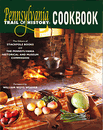Love Feast
This article originally appeared in Pennsylvania Trail of History Cookbook
Founded in 1732 by Conrad Beissel along the Cocalico Creek in Lancaster County, Ephrata Cloister was one of America's earliest religious communities. Although some members were celibate, there were married members who lived in individual homes, had children, cultivated farms, and were similar to their Pennsylvania Dutch neighbors.
Many members of the Ephrata community led a strictly disciplined lifestyle in the hope that their souls would unite with God. Daily life at Ephrata stressed the ascetic life, with a monastic schedule and dress. Members spent only six hours at rest each day, divided by a two-hour midnight worship service, and tried to subsist with little daily nourishment. Believing that certain foods aroused distracting ideas, members generally avoided meat. A 1753 account describes an evening meal consisting of pearled barley boiled in milk with bread broken into it, pumpkin mush, and slices of bread with butter.
The most important ritual celebrated at Ephrata was the Love Feast, which was held periodically within the community. The ritual could last five to six hours and included three parts: foot washing, a fellowship meal, and holy communion. Foot washing symbolized humility and a possible cleansing from sin, and in Ephrata was also a sign of hospitality.
The communal meal was more ample than the ordinarily spare meals. The usual ban on meat was relaxed for the occasion, and lamb stew was often served - a reminder of Christ as the Lamb of God and Shepherd of the flock. Love Feasts were held on a number of occasions, including building dedications and memorials for members who had died. They could involve the whole community or just select individuals.
In western Pennsylvania, another community practiced the Love Feast (Liebesmahl): the Harmony Society at Old Economy Village in Ambridge, Beaver County. Founded in Germany in 1785, the Harmony Society ultimately moved to Economy in 1825 under the leadership of George Rapp (1757-1847). Members signed a covenant turning overall their possessions to the society, which then agreed to supply all necessities. Celibacy was strictly adhered to, and husbands and wives were expected to live as though they were brother and sister. The community supported itself as a manufacturing organization, primarily through wool, silk, and textile production.
The Love Feast was held in the Feast Hall and Museum Building (1826), the largest building of the Harmonist complex. Because outsiders were not invited to their Love Feasts, little is known about the meals. They probably included a stew of beef, pork, or lamb, along with rice or spaetzel. Before the feast, members confessed all their individual differences before Father Rapp and might have participated in the ritual of giving each other the "kiss of peace" on the cheek.
Love Feasts were held on the anniversary of the society's founding (February 15), on Easter, Christmas, Harvest Home, and often when there was a perceived need. When there was a schism within the group in 1832, Love Feasts were held as often as three times a week in an effort to resolve divisive problems. The meal and religious service of each feast lasted all day.
Visit
Ephrata Cloister, Ephrata, PA
Discover the religious community noted for its art and architecture.
Old Economy Village, Ambridge, PA
The Harmonists, a Christian communal society, founded Old Economy Village in 1824.
For Further Reading
 |
Pennsylvania Trail of History Cookbook Edited by Kyle R. Weaver, Diane B. Reed, and Fred Lauver Forward by William Woys Weaver Stackpole Books and Pennsylvania Historical and Museum Commission 2004 |
 |
Old Economy Village: Pennsylvania Trail of History Guide by Daniel B. Reibel Stackpole Books and Pennsylvania Historical and Museum Commission 2002 |


